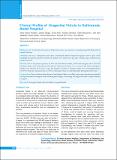Please use this identifier to cite or link to this item:
https://hdl.handle.net/20.500.14356/1262Full metadata record
| DC Field | Value | Language |
|---|---|---|
| dc.contributor.author | Pradhan, Hema Kumari | - |
| dc.contributor.author | Dangal, Ganesh | - |
| dc.contributor.author | Karki, Aruna | - |
| dc.contributor.author | Shrestha, Ranjana | - |
| dc.contributor.author | Bhattachan, Kabin | - |
| dc.contributor.author | Upadhyay, Amit Mani | - |
| dc.contributor.author | Poudel, Rekha | - |
| dc.contributor.author | Bajracharya, Nishma | - |
| dc.contributor.author | Tiwari, Kenusha Devi | - |
| dc.contributor.author | Bharati, Sonu | - |
| dc.date.accessioned | 2023-05-04T06:19:15Z | - |
| dc.date.available | 2023-05-04T06:19:15Z | - |
| dc.date.issued | 2020 | - |
| dc.identifier.citation | PradhanH. K., DangalG., KarkiA., ShresthaR., BhattachanK., UpadhyayA. M., PoudelR., BajracharyaN., TiwariK. D., & BharatiS. (2020). Clinical Profile of Urogenital Fistula in Kathmandu Model Hospital. Journal of Nepal Health Research Council, 18(2), 210-213. https://doi.org/10.33314/jnhrc.v18i2.2376 | en_US |
| dc.identifier.issn | Print ISSN: 1727-5482; Online ISSN: 1999-6217 | - |
| dc.identifier.uri | http://103.69.126.140:8080/handle/20.500.14356/1262 | - |
| dc.description | Original Article | en_US |
| dc.description.abstract | Abstract Background: To determine the causes of fistula and to share our experience in treating urogenital fistula and its surgical outcome. Methods: This was a retrospective study done at Kathmandu Model Hospital from January 2014 to June 2019 including 261 patients operated for fistula. The patients were analyzed for age, type of fistula, cause, treatment and surgical outcome. Results: Out of 261 patients operated, 59.38% cases had obstetric fistula, 38.69% had iatrogenic and 1.92% had traumatic fistula. Most of the patients with obstetric fistula were between 21 to 25 years of age whereas iatrogenic fistulae were between 46-50 years of age. The majority (54.84%) of obstetric fistulae were vesicovaginal fistula (54.84%) while the commonest type (77.36%) of iatrogenic fistula was vault fistula after abdominal hysterectomy. Conclusions: This study showed that obstructed and neglected labor was still the major cause of genitourinary fistula in Nepal nevertheless iatrogenic fistula following pelvic surgery is increasing. The surgical outcome of repair of fistula was good. Keywords: Latrogenic fistula, obstructed labour, urogenital fistula. | en_US |
| dc.language.iso | en | en_US |
| dc.publisher | Nepal Health Research Council | en_US |
| dc.relation.ispartofseries | Apr-June, 2020;2376 | - |
| dc.subject | Latrogenic fistula | en_US |
| dc.subject | obstructed labour | en_US |
| dc.subject | urogenital fistula | en_US |
| dc.title | Clinical Profile of Urogenital Fistula in Kathmandu Model Hospital | en_US |
| dc.type | Journal Article | en_US |
| local.journal.category | Original Article | - |
| Appears in Collections: | Vol. 18 No. 2 Issue 47 Apr-Jun 2020 | |
Files in This Item:
| File | Description | Size | Format | |
|---|---|---|---|---|
| 2376-Manuscript-17517-1-10-20200911.pdf | Fulltext Download | 260.96 kB | Adobe PDF |  View/Open |
Items in DSpace are protected by copyright, with all rights reserved, unless otherwise indicated.
